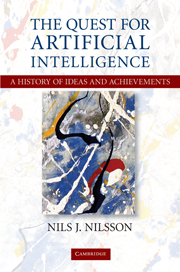Book contents
- Frontmatter
- Contents
- Preface
- PART I BEGINNINGS
- PART II EARLY EXPLORATIONS: 1950S AND 1960S
- PART III EFFLORESCENCE: MID-1960S TO MID-1970S
- PART IV APPLICATIONS AND SPECIALIZATIONS: 1970s TO EARLY 1980s
- PART V “NEW-GENERATION” PROJECT
- PART VI ENTR'ACTE
- PART VII THE GROWING ARMAMENTARIUM: FROM THE 1980s ONWARD
- PART VIII MODERN AI: TODAY AND TOMORROW
- Index
- Plate section
PART IV - APPLICATIONS AND SPECIALIZATIONS: 1970s TO EARLY 1980s
Published online by Cambridge University Press: 05 August 2013
- Frontmatter
- Contents
- Preface
- PART I BEGINNINGS
- PART II EARLY EXPLORATIONS: 1950S AND 1960S
- PART III EFFLORESCENCE: MID-1960S TO MID-1970S
- PART IV APPLICATIONS AND SPECIALIZATIONS: 1970s TO EARLY 1980s
- PART V “NEW-GENERATION” PROJECT
- PART VI ENTR'ACTE
- PART VII THE GROWING ARMAMENTARIUM: FROM THE 1980s ONWARD
- PART VIII MODERN AI: TODAY AND TOMORROW
- Index
- Plate section
Summary
Until about the early 1970s, most ai research dealt with what seymour Papert called “toy” problems – programs that solved puzzles or games – or the researchers pursued projects that were staged in highly controlled laboratory settings. (Of course, there were some notable exceptions – machine translation, DENDRAL, and LUNAR, for example.) However, soon after, AI efforts began a definite shift toward applications work, confronting problems of real-world importance. Inevitably, successful applications work encouraged specialization into sub-disciplines such as natural language processing, expert systems, and computer vision.
One reason for the increasing interest in applications was that the power of AI methods had increased to the point where realistic applications seemed within reach. But perhaps more importantly, the sponsors of AI research in the U.S. Department of Defense (DoD) had to deal with the constraints imposed on them by the 1969 “Mansfield Amendment,” which required that basic research be relevant to military needs. As one example of the increased emphasis on applications, the Information Sciences Institute (USC-ISI) was formed in 1972 specifically to pursue them. Located in Marina Del Rey, California, it is affiliated with the University of Southern California and received much of its initial support from DARPA. Other large corporations also began to explore AI's commercial potential.
- Type
- Chapter
- Information
- The Quest for Artificial Intelligence , pp. 207 - 208Publisher: Cambridge University PressPrint publication year: 2009



